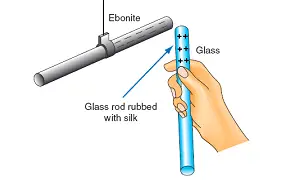| 1. | Matter can exist in any one of four states—solid, liquid, gas and:
|
| 2. | The smallest particle into which any one chemical can be divided without changing the characteristics of that chemical is called:
|
| 3. | Atoms are very small particles that:
|
| 4. | The nucleus of an atom contains protons, which are,
|
| 5. | In an atom, it is assumed that the attraction between the positively charged nucleus and the negatively charged electrons provides the force necessary to keep the electrons adjacent to the nucleus, while their motion keeps the electrons:
|
| 6. | The atomic number, of an element is the number of:
|
| 7. | The number and arrangement of electrons around the nucleus of an atom determines:
|
| 8. | The outer shell of an atom is often called the:
|
| 9. | A non-ionised copper atom has 29 electrons in its orbits distributed as 2, 8, 8, 10, 1. For these reasons, copper is said to be a:
|
| 10. | Sulphur has an electron configuration of 2, 8, 6 with six electrons in its outer orbit, and is said to be a:
|
| 11. | The process by which an originally neutral atom becomes charged by the removal of electrons is called:
|
| 12. | An electric current is established when:
|
| 13. | When current flow occurs in a solid conductor, an external influence causes the electrons to be attracted:
|
| 14. | When current flow occurs in a liquid, the:
|
| 15. | Gas atoms:
|
| 16. | The energy levels in a plasma are so high that the atoms are ionized and the electrons flow directly through an electric field, from:
|
| 18. | If an electrically charged glass rod is suspended from silk thread, a second glass rod that has been rubbed with silk will:
|
| 19. | A material with an electrostatic charge is said to possess an electrical potential, and the difference in electrical potential between two bodies is measured in:
|
| 20. | In dry weather, a person may experience an electric spark by touching a car door. This is because the:
|
| 21. | An electron flow can only occur if a conducting path exists between two bodies and if there is a sufficient difference in potential between those bodies to cause an electron flow. The force that causes the electrons to flow is called:
|
| 22. | Once the potential difference between two points has been reduced to zero, the flow of electrons will:
|
| 23. | A conductor is a material that will:
|
| 24. | The source of electricity generated by electric conductors moving through a magnetic field is called an:
|
| 25. | A piezoelectric source of electromagnetic energy is one where the electric potential is generated by:
|
| 26. | The great bulk of electrical energy is generated through electromagnetic generation. Fossil fuel is burned to generate the heat required to:
|
| 27. | When driving supply system alternators, gas turbines, are noted for their good efficiency:
|
| 28. | Most electrochemical sources consist of:
|
| 29. | The solar cell is basically a large semiconductor diode, when light falls on the junction, light energy:
|
| 30. | Modern solar cells have efficiencies of around:
|
| 31. | The uses for static electricity in industry are growing. A typical use is:
|
| 32. | The thermoelectric method of voltage generation is mostly used:
|
| 33. | Look at the following diagram: 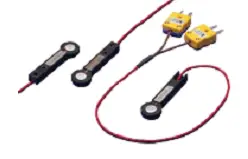 Thermocouples, as shown in the above illustration, consist of:
|
| 34. | When generating a voltage by the piezoelectric effect, the value of the voltage is:
|
| 35. | The natural rate of resonance of a Piezo crystal depends mainly on the:
|
| 36. | Early power-distribution systems supplied consumers with:
|
| 37. | Almost without exception, electrical energy is today distributed to consumers using:
|
| 38. | The reason for using high voltages for the long-distance transmission of power is to:
|
| 39. | Look at the following diagram: 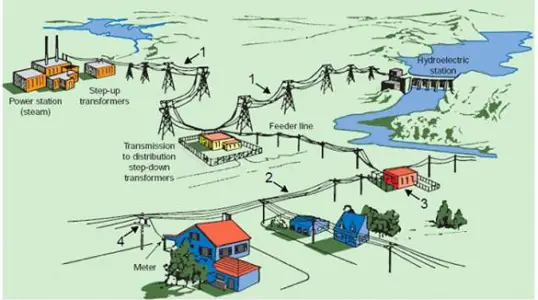 The diagram shows a stylized layout for an electrical transmission and distribution system. With reference to the diagram, the item marked ‘3’ is a:
|
| 40. | Materials which offer a high opposition to the flow of electricity are called:
|
| 41. | Metals do not conduct equally well. Of the metals, the best conductor is:
|
| 42. | The most outstanding characteristic of an insulator is that under normal conditions it contains:
|
| 43. | At very low temperatures, some materials exhibit a condition known as superconductivity. At the superconducting temperatures:
|
| 44. | If the current path is not continuous between two points of potential difference, the circuit is referred to as:
|
| 45. | To maintain a continuous current flow in a circuit, a continuous source of electrical energy must be provided to:
|
| 46. | When a “short-circuit” occurs in an electrical circuit:
|
| 47. | Electric current is the coordinated flow of electrons from:
|
| 48. | In a circuit, conventional current flow is said to go from:
|
| 49. | Electromotive force is:
|
| 50. | The rate of flow of electricity is measured in:
|
| 52. | Ammeters are used to measure the:
|
| 53. | Ammeters have very low resistance so that they will not restrict the flow of current in a circuit any more than necessary. If they are connected in parallel with a voltage source:
|
| 54. | Voltmeters are intended to measure voltage and therefore are connected:
|
| 55. | Look at the following diagram: 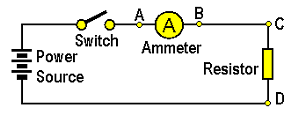 To read the voltage across the load resistor in the above circuit, the voltmeter should be connected to points:
|
| 56. | The maximum capacity of a meter is termed its full-scale deflection value f.s.d. If any meter pointer moves past the full scale deflection, then the meter:
|
| 57. | Ohm’s Law states that the current flowing between any two points in an electric circuit is directly proportional to the:
|
| 58. | Look at the following diagram: 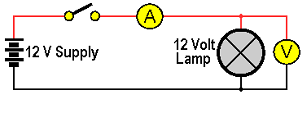 In the above circuit, if the lamp has a resistance of 6 W, when the switch is closed the current in the circuit will be:
|
| 59. | A given lamp draws 4 A when powered by a 12 V battery. The resistance of this lamp is:
|
| 60. | According to Ohm’s Law, the voltage between two points in a circuit is equal to the:
|
| 61. | Power is defined as the:
|
| 62. | Power can be measured directly with an instrument known as:
|
| 63. | The power dissipated by a resistor can be determined using the formula:
|
| 64. | A car with a 12 V battery has a driving light rated at 100 W each. When the light is switched on, the current drawn from the supply will be:
|
| 65. | A 230 V household light fitting has 6 x 40 W lamps. The value of current drawn from the supply will be:
|
| 66. | Look at the following diagram:  With reference to the connection diagram for a wattmeter shown above, the meter has two measuring circuits; one to measure the current and the other to measure the:
|
| 67. | The electrical energy consumed by a circuit is a product of the
|
| 68. | An electric heater rated at 1200 W has been switched on for an average of 4 hours per day for 7 days. The electrical energy consumed during that period will be:
|
| 69. | Look at the following diagram: 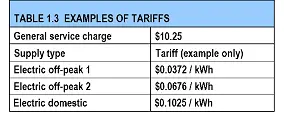 In a given time period a private residence consumes 1200 kWh of energy charged at the domestic rate and 750 kWh of energy charged at the off-peak 1 rate. Using the above tariffs, the cost of the electric energy for the period will be:
|
| 70. | Resistors are components that resist the flow of:
|
| 71. | In electronics and some electrical applications, resistors are used to control:
|
| 72. | An ‘inductor’ is a component that can induce:
|
| 73. | When current flows through an inductor, a magnetic field is generated which then passes through other parts of the coil. This causes a voltage to be generated in the coil that:
|
| 74. | A transformer can transform voltages from one value to another. It does this by converting electrical energy to:
|
| 75. | Capacitors are devices for storing an electrical charge in:
|
| 76. | Chimney stacks in power stations often have electrostatic generators that energise the smoke particles so they:
|
| 77. | One example of the electrochemical effect of an electric current is:
|
| 78. | When a current flows through a conductor heat is produced, which:
|
| 79. | The magnetic effect of an electric current can be increased by:
|
| 80. | The general effect of electric shock on the human body is such that levels of current less than 10 mA cause muscle pain and shaking, while levels up to about 30 mA:
|
| 81. | Heat is energy stored in a body, whereas temperature is:
|
| 82. | When heat is stored in a body, the temperature rises according to the:
|
| 83. | The SI unit of temperature is the:
|
| 84. | Absolute zero temperature is considered to be:
|
| 85. | The SI unit for heat energy is the:
|
| 86. | The amount of energy that is contained in a body of material has been found to depend on three parameters. These are: the mass of material in the body, the type of material and the:
|
| 87. | The specific heat capacity of a material is defined as the quantity of heat energy required to raise the temperature of a mass of:
|
| 88. | An urn containing 15 litres of water is heated from room temperature 25ºC to boiling point 100ºC (Note: The specific heat capacity of water is 4180 J/kgK). The amount of heat energy delivered to the urn is:
|
| 89. | A aluminium block of mass 1.25 kg has 2.2 kJ of heat energy added (Note: The specific heat capacity of copper is 390 J/kgK). If the initial temperature was 20ºC, then the final temperature of the block will be:
|
| 90. | There are three recognised processes of heat transfer—conduction, convection and:
|
| 91. | The rate of heat conduction through a material depends on the temperature difference across the material, the cross-sectional area of transfer path, the length of transfer path and the:
|
| 92. | Poor thermal conductors of heat offer higher opposition to heat energy flow and are therefore considered to be:
|
| 93. | The thermal conductivity of a material is the ability of that material to:
|
| 94. | The heat energy that results from an electric current flow is determined by, the power used by the appliance multiplied by the:
|
| 95. | The heat energy generated by an electric current can be determined using the formula:
|
| 96. | An electric motor has been overloaded and is stalled. The supply is 32 volts and the motor has a winding resistance of 4 W. If it takes 1.25 minutes for the protection to operate, then the heat energy generated will be:
|
